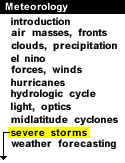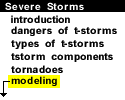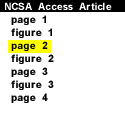
|
 |
|
| Droegemeier has been simulating severe storms for 15 years, first as
a graduate student working with Robert Wilhelmson at the University of
Illinois at Urbana-Champaign (and now also at NCSA), where he reproduced
storms to understand how they formed, and later as a professor at the University
of Oklahoma, where he built forecasting models and studies of the dynamics
and predictability of storms. In 1989, he and an Oklahoma colleague, Doug
Lilly, were awarded an 11-year grant from the National Science Foundation
to establish a
Science
and Technology Center that would go beyond predicting the conditions
favorable to the formation of severe storms to predicting when and where
a storm will strike. The result was ARPS.
ARPS was designed for all types of local high-impact weather but has been tested most extensively on the so-called supercell storms: the towering thunderstorms that darken skies in the spring and can unleash within their one- to two-hour lifespans the energy equivalent to several atomic bombs. "Supercell storms are among the most menacing weather events," says Droegemeier, "and are difficult to predict with computer models." Why? Meteorologists have known since the 1950s that thunderstorms form where cold, dry air overlies warm, moist air. Some slight instability shoves the warm air upwards, triggering a cycle of updrafts and downdrafts that erupt into storms. A hitch has been identifying these triggers. A mountain range will do it, but so will small differences in vegetation and soil moisture. Then there's predicting the motion and decay of the storms once they form. |
|

figure 1 |
|

figure 2 |







